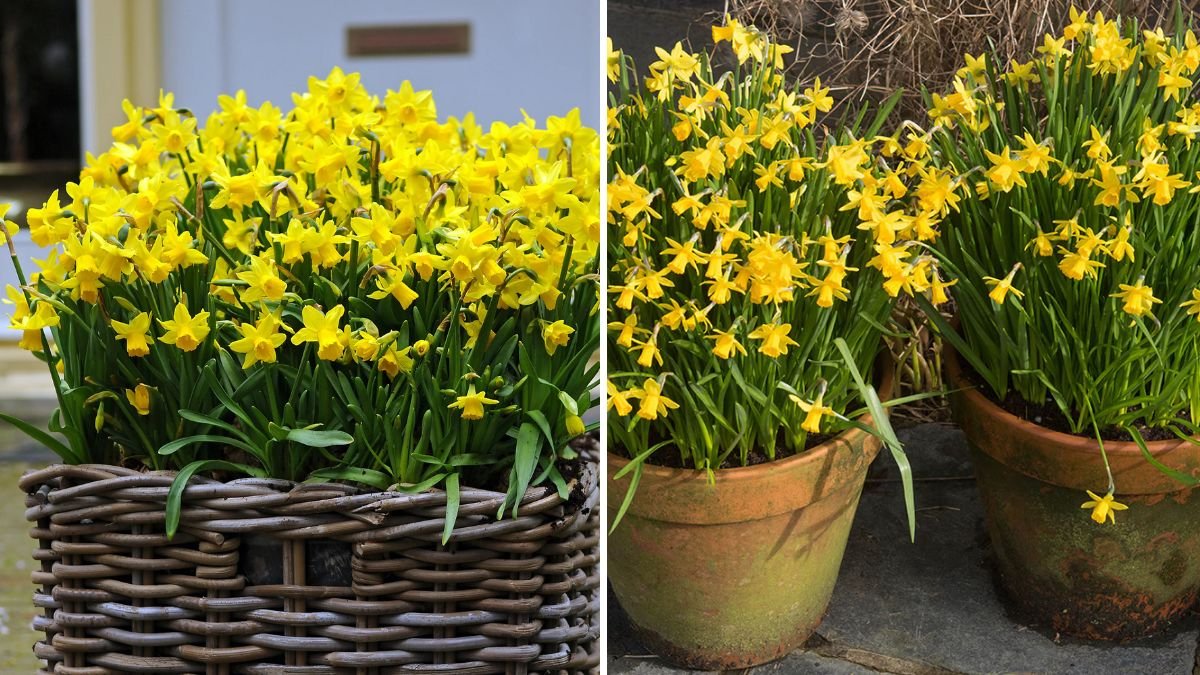Daffodils (Narcissus spp.) are one of the earliest signs of spring, celebrated for their bright yellow, white, or orange blooms and elegant trumpet-shaped flowers. Growing daffodils in pots allows gardeners to enjoy early flowering, even in small spaces, balconies, or patios. With proper care, container-grown daffodils can bloom earlier than those in the ground and can be moved indoors or to sheltered spots to extend their flowering season.
This article provides a comprehensive guide on how to grow daffodils in pots for early blooms, covering selection, planting, soil preparation, care, and seasonal strategies.
1. Why Grow Daffodils in Pots?
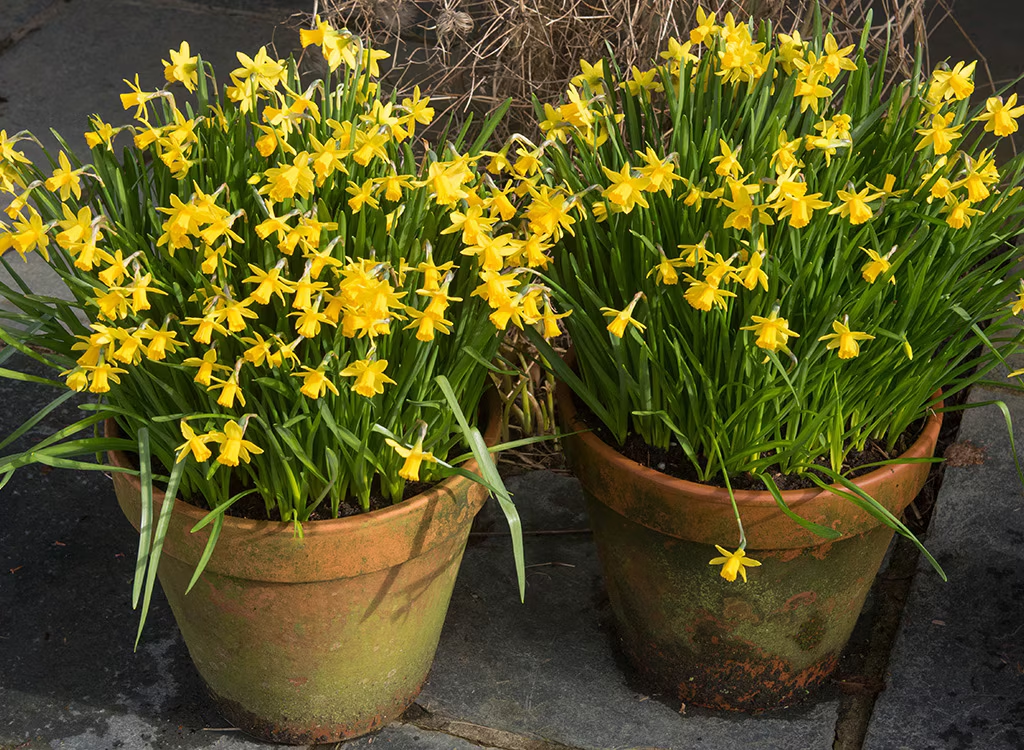
Growing daffodils in containers offers several advantages:
- Early Blooms: Containers can be placed in warmer spots or indoors to force early flowering.
- Space Efficiency: Ideal for balconies, patios, and small gardens.
- Aesthetic Flexibility: Daffodils can be grouped or arranged with other spring plants for visual appeal.
- Mobility: Pots can be moved to optimize sunlight exposure and protect from frost.
- Pest Protection: Raised pots reduce the risk of ground-dwelling pests such as slugs or rodents.
Container gardening ensures beautiful spring blooms even in limited space or cooler climates.
2. Selecting the Right Daffodil Varieties
The choice of daffodil variety influences bloom time and aesthetic appeal:
- Early Bloomers: ‘February Gold,’ ‘Tete-a-Tete,’ and ‘Jetfire’ produce flowers in late winter or early spring.
- Mid-Season Bloomers: ‘Carlton’ and ‘King Alfred’ bloom in early to mid-spring.
- Miniature Varieties: Perfect for small pots and compact spaces.
- Large-Flowered Types: Provide dramatic displays and are suitable for feature pots.
Selecting early-flowering or miniature varieties ensures bright and prompt spring blooms in pots.
3. Choosing the Right Container
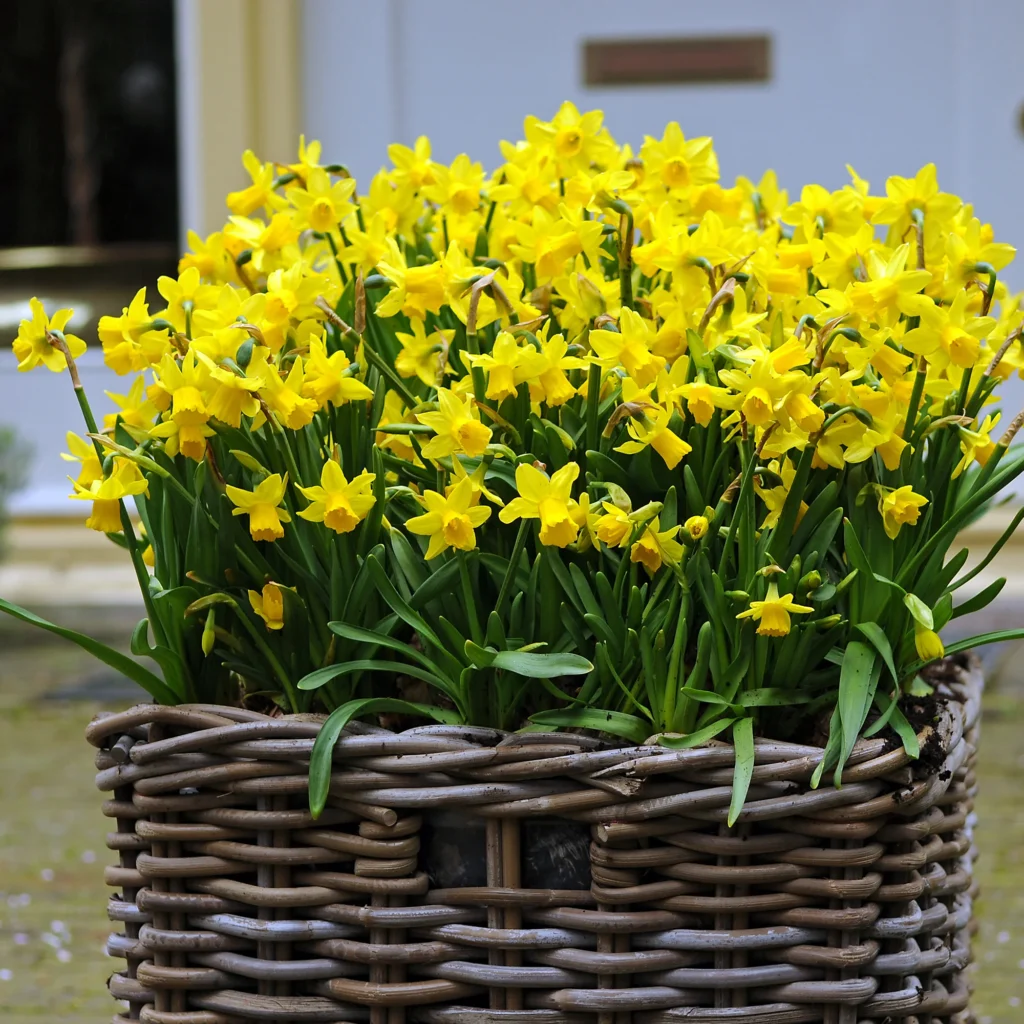
Proper container selection is critical for healthy daffodil growth:
- Size: At least 6–8 inches deep for standard bulbs; larger pots for multiple bulbs.
- Material: Plastic, ceramic, or terracotta; lightweight options allow easy mobility.
- Drainage: Ensure multiple holes to prevent waterlogging and bulb rot.
- Shape: Wide containers allow spacing multiple bulbs for a fuller display.
A well-chosen pot ensures healthy root development and robust flowering.
4. Preparing the Soil Mix
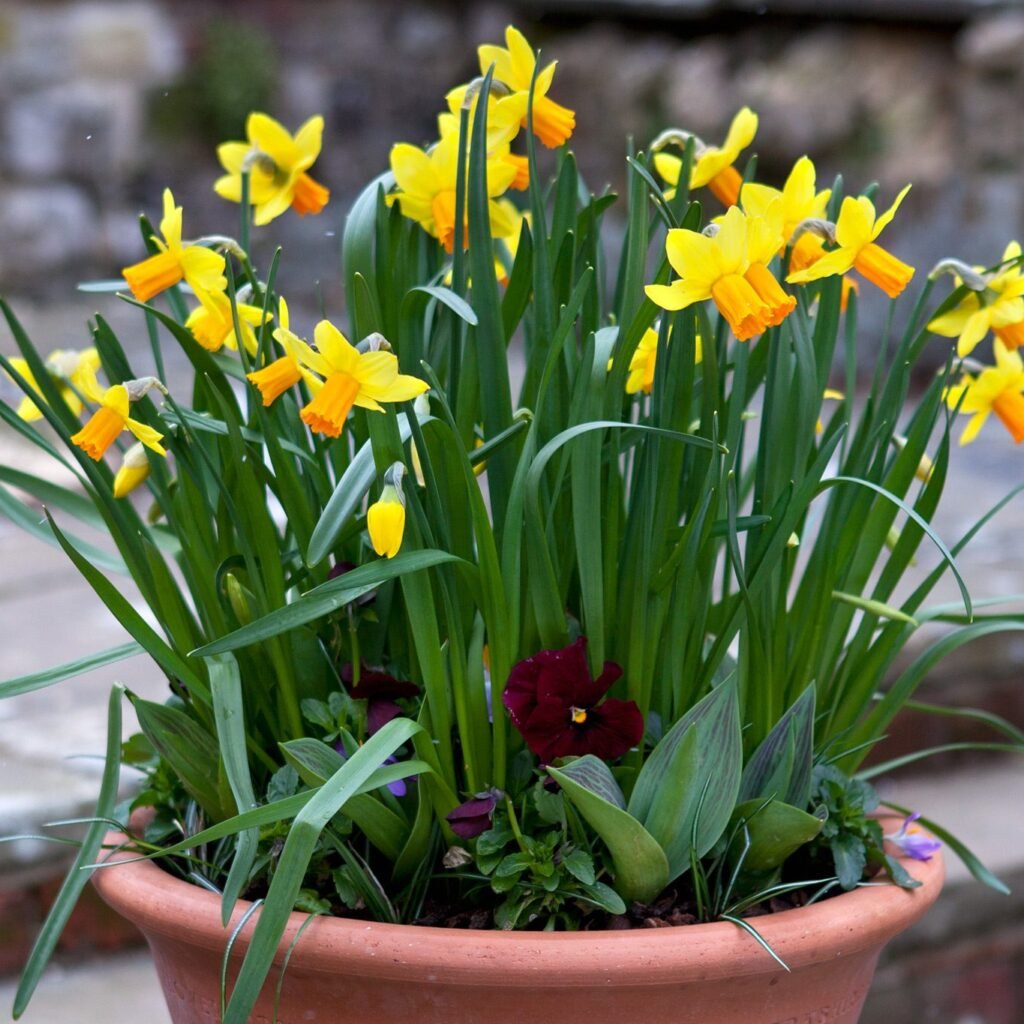
Daffodils prefer well-draining soil rich in organic matter:
- Mix Composition: 40% garden soil or potting soil, 30% compost, 20% coco peat or peat moss, 10% perlite for drainage.
- pH Requirement: Slightly acidic to neutral (6.0–7.0).
- Fertility: Enrich the soil with slow-release fertilizer to support early growth.
- Moisture Retention: Soil should retain enough water without becoming soggy.
A balanced soil mix ensures strong roots, healthy foliage, and vibrant blooms.
5. Planting Daffodils in Pots
Correct planting technique is essential for early flowering:
- Layering Bulbs: For full bloom, plant bulbs in tiers: larger bulbs at the bottom, smaller ones above.
- Planting Depth: Bulbs should be planted 2–3 times their height deep.
- Spacing: Keep bulbs 2–3 inches apart to prevent overcrowding.
- Orientation: Point the bulb’s tip upward for proper sprouting.
- Watering After Planting: Gently water to settle soil without causing compaction.
Proper planting ensures strong growth and synchronized blooms.
6. Forcing Daffodils for Early Bloom
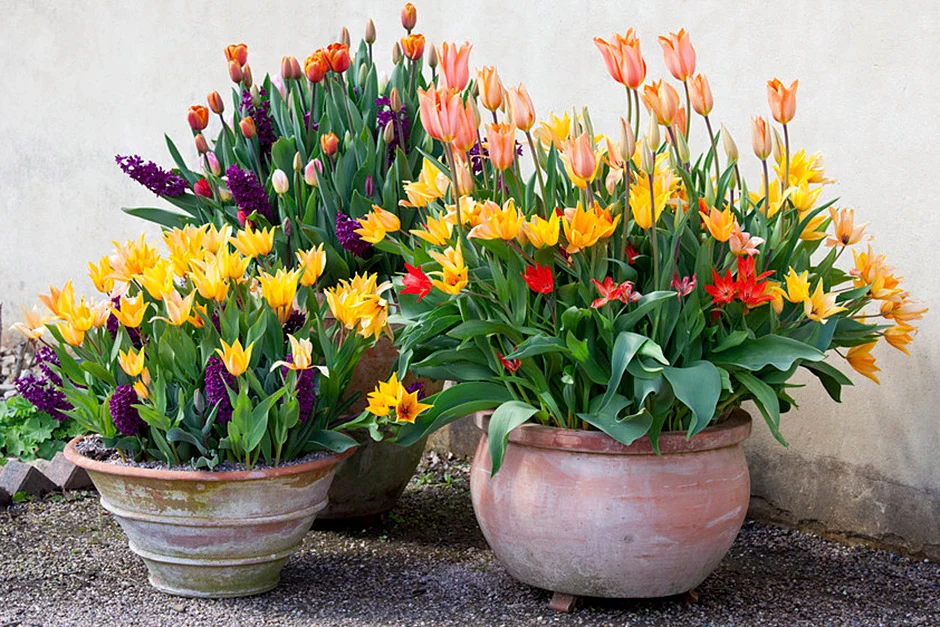
For indoor or early outdoor flowering, bulbs can be pre-chilled and forced:
- Pre-Chilling: Place bulbs in a cool, dark area (35–45°F / 2–7°C) for 12–16 weeks.
- Potting: Plant chilled bulbs in pots with well-draining soil.
- Indoor Placement: Move pots to a sunny, cool indoor location after chilling.
- Temperature Transition: Gradually increase sunlight exposure to stimulate flowering.
Forcing allows gardeners to enjoy blooms weeks ahead of the outdoor season.
7. Sunlight Requirements
Daffodils need adequate light for healthy growth and flowering:
- Indoors: Place pots near a south-facing window for 6–8 hours of sunlight.
- Outdoors: Full sun or partial shade ensures early bloom and vibrant flowers.
- Rotating Pots: Rotate regularly to ensure uniform growth and flowering.
Sufficient sunlight ensures strong stems, lush foliage, and early, vibrant blooms.
8. Watering Practices
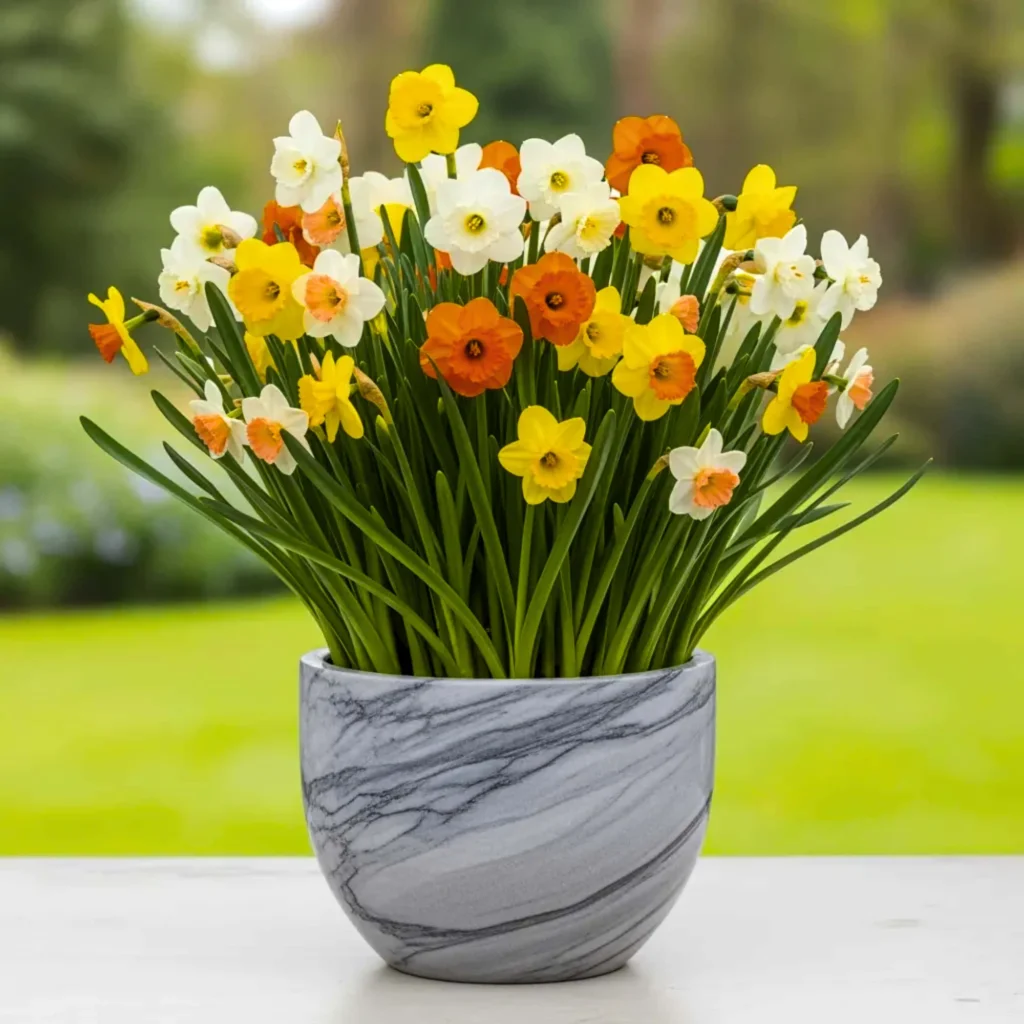
Proper watering is key to container-grown daffodils:
- Frequency: Water when the top inch of soil is dry.
- Amount: Keep soil moist but avoid waterlogging, which can cause bulb rot.
- Mulching: Apply light mulch to retain moisture and regulate temperature.
- Indoor Watering: Avoid overwatering; indoor pots dry out slower than outdoor pots.
Consistent watering promotes healthy foliage and robust early flowering.
9. Fertilization for Continuous Growth
Fertilization encourages strong roots and abundant blooms:
- Pre-Planting: Incorporate slow-release bulbs fertilizer in the potting mix.
- Post-Planting: Apply liquid fertilizer when shoots emerge.
- Blooming Period: Feed every 2–3 weeks with a balanced fertilizer to sustain growth.
- After Flowering: Reduce fertilizer to allow bulbs to store energy for the next season.
Proper feeding ensures vivid flowers and lasting plant health.
10. Seasonal Care and Maintenance
Seasonal adjustments enhance blooming potential:
- Winter: Keep potted bulbs cool and dormant until growth begins.
- Spring: Provide consistent water, sunlight, and occasional fertilizer.
- Summer: Allow foliage to die naturally after flowering; reduce watering.
- Autumn: Prepare bulbs for the next season; replace soil if necessary.
Seasonal care ensures healthy bulbs and early blooms year after year.
11. Pest and Disease Management
While daffodils are generally hardy, container cultivation requires attention:
- Common Pests: Aphids, bulb flies, slugs, and snails.
- Diseases: Bulb rot, basal rot, and fungal infections.
- Preventive Measures: Ensure proper drainage, remove dead foliage, and inspect regularly.
- Organic Control: Neem oil or insecticidal soap for pests; fungicides for fungal infections.
Healthy bulbs produce strong stems and vibrant flowers without pest interference.
12. Display and Design Ideas
Potted daffodils can enhance any balcony, patio, or garden space:
- Groupings: Plant multiple pots together for a striking early-spring display.
- Color Combinations: Mix yellow, white, and orange varieties for contrast.
- Layered Planting: Combine with early-blooming tulips or crocuses for extended color.
- Container Styles: Use decorative ceramic or terracotta pots to complement garden aesthetics.
- Mobility: Move pots to windows, terraces, or sheltered spots to adjust for sunlight and temperature.
Thoughtful design ensures visual impact and prolonged enjoyment of blooms.
13. Reusing Potted Daffodils
After blooming, potted daffodils can be prepared for future seasons:
- Foliage Management: Allow leaves to yellow naturally to store nutrients.
- Bulb Storage: In hot climates, move bulbs to cool, shaded areas after foliage dies.
- Replanting: Use fresh soil and compost each season to maintain health.
- Division: If pots become crowded, separate bulbs to prevent competition.
Proper post-bloom care ensures strong, early blooms in the following season.
Conclusion
Growing daffodils in pots provides gardeners with early, vibrant blooms even in small or urban spaces. By selecting early-flowering varieties, preparing well-draining soil, and implementing proper planting, sunlight, watering, and fertilization practices, container-grown daffodils can bloom reliably from late winter into spring. Seasonal adjustments, pest management, and careful post-bloom care ensure that bulbs remain healthy and productive year after year.
With thoughtful planning and attention, potted daffodils transform balconies, patios, and garden corners into bright, cheerful spaces heralding the arrival of spring.
